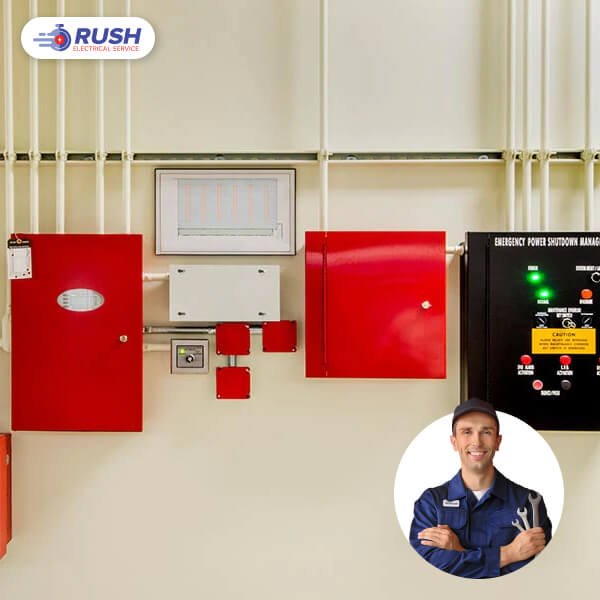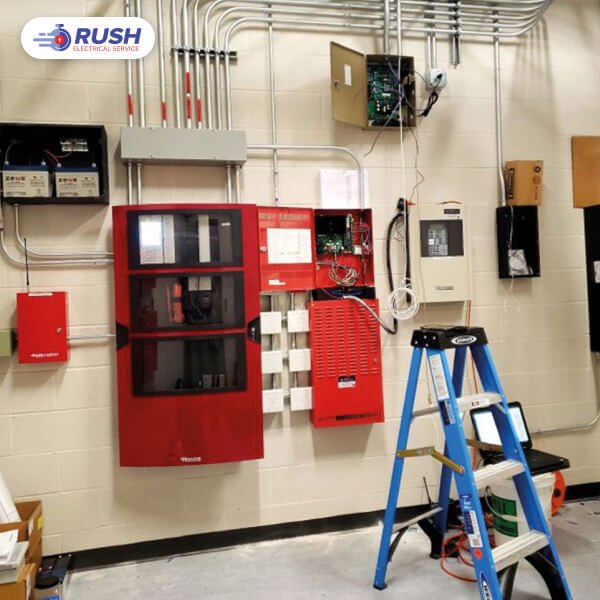What Are the Types of Fire Alarm Systems?

You plan to install a fire alarm system and wonder which system type to choose. Don’t worry! We’re here to provide sufficient information on the different fire alarm systems.
Ultimately, the type of alarm system for your property will depend on your property’s requirements, as well as your needs and preferences. However, you can always acquire some new information here and there to make the best decision. The most important thing is that you hire reliable fire alarm services.
If you wish to get a professional installation, repair, or maintenance, Rush Electrical Serviceis a great choice. But before you can make that call, you want to take a stop and maybe immerse yourself in the world of fire alarms. In this writing, you will learn how these devices are installed. You will also see the importance of having them on your property.
The 2 Types of Fire Alarm Systems
There are basically two types of fire alarm monitoring systems. They can be easily identified because one is automatic, and the other is manual. You must think it’s a no-brainer to decipher their differences, but there are more to these types of alarms that you should know.
- Manual-initiating alarm system. Manual fire alarm systems are pull-down devices that you can only activate by hand. You must be familiar with this fire alarm because it is often seen in commercial buildings, such as offices, event centers, retail stores, and sports arenas.
The state and local laws require these types of fire alarm systems. The fire alarm standard by NFPA 72 has corresponding codes that should determine the location and position of these fire alarms in a building.
How to activate a manual fire alarm?
The manual fire alarm system allows people or building occupants to activate the fire alarm. In the case of an emergency, they can initiate it by hand.
Manual fire alarms have two types of pull stations: the single-action pull and the dual-action pull station. The single-action station lets an individual initiate the fire alarm by pulling a lever downward once.
On the other hand, a two-action station is much like the two-factor authentication we go through on online applications. This type of system asks someone to do two actions to set off the fire alarm. An individual has to break a cabinet made of glass or detach a plastic cover that houses the pull station,
- Automatic-initiating alarm system. As the name suggests, automatic fire alarm systems are designed to trigger automatically in the case of fires. Fire sprinklers, smoke detectors, and heat detectors are some of the devices that belong to the automated fire alarm monitoring system.
An automated fire alarm system has two distinct types of operation: spot-type and linear type. Here’s how to distinguish between the two:
Spot-type:
- Detects smoke and fire in near and immediate areas.
- Includes the smoke alarm installed in kitchens (residential smoke detectors).
If there’s burnt dinner in your kitchen, only the nearest detector will trigger, excluding all the rest of the smoke detectors in the house.
Linear type:
- Detects smoke and fire in a wider range of space.
- Submits a signal to the central control panel.
- Works best in larger commercial buildings.
- Helps the control panel locate the exact alarm location.
Simply, linear types can easily establish where the emergency or fire occurs.
How does an automatic fire alarm system work?
Automatic fire alarm systems automatically send a signal to the control panel after receiving it from a fire sensor (such as a smoke, heat, or carbon monoxide detector).
These devices use radiofrequency in their wireless systems to convey the signal from the detectors to the control panel. Thermistors are frequently included as part of heat detectors to detect heat.
Follow These 5 Steps to Wire a Fire Alarm System

There are a few steps you need to take to wire a fire alarm system.
Step 1: Preparing the tools and the work area.
Make sure you have the right tools for the job. You’ll need a wire stripper, a crimper, and some electrical tape—you can get all of these at any hardware store.
After that, it’s time to prepare your work area. Make sure you’re in a well-ventilated area with plenty of room for movement. It will be easier when you start working on the wires later.
Step 2: Work on the breaker and shut off the power.
You’ll need to find an existing circuit breaker box. Once you’ve found it, turn off the main power supply and remove any existing circuit breakers or fuses. Disconnect your home’s electrical service by flipping off the main breaker switch. Then, attach a new circuit breaker in its place.
Now that the power has been shut off and you’ve installed your new circuit breaker, it’s time to install your fire alarm panel and connect it to your new circuit breaker. Once that’s done, reconnect the main power supply and turn it back on.
Step 3: Preparing and sizing the wires.
The next step is to identify which wires need to connect together. Then connect them using a wire stripper tool and crimping pliers (if needed). Make sure everything is tightly secured by taping over any exposed areas with electrical tape.
Check the wire length and sizes used in your system. The wire should be a minimum of 14 gauge if it is exposed to fire and 12 gauge for areas where it will not be exposed to heat or flames. You can use smaller gauges if you’re using a shorter length of wire, but anything smaller than 12 will probably be too thin for most fire alarm systems.
Step 4: Connecting the wires.
Connect one end of your new cable to the terminal marked “common” or “COM” on your alarm control panel, usually located near the front door or box where smoke detectors are installed.
Connect the other end of your new cable to each switch you want to be connected to an individual alarm sensor (for example, connecting one end of your new cable to both ends of a motion detector). If you have more than one motion detector in a room, connect all additional motion detectors together with wire nuts (instructions below).
Step 5: Testing the alarm.
Finally, test your fire alarm system by pressing each button to see if anything happens! If everything works as intended, congratulations—you can now rest easy knowing that your device will notice any potential fires before they become too big of a problem for you or anyone else living nearby.
The Importance of Installing Fire Alarm Systems
When it comes to people’s safety, you don’t want to take any chances. That’s why installing a fire alarm system is so important.
A fire alarm system is designed to detect the presence of smoke or fire and alert the people inside the structure that there’s an emergency. It also activates an alarm so everyone knows what’s happening and how they should act.
Fire alarms are critical for businesses, schools, hospitals, and other public buildings where lives are at risk if a fire breaks out. They can be helpful in residential buildings as well. They will alert residents when there is a fire so that they get out before it’s too late!
There are many different types of fire alarms available today, from smoke to heat detectors, all designed for specific purposes. Some systems even have multiple types of sensors installed at once!
You can choose to install fire alarm devices that automatically activate, and you can opt for one that you can initiate manually. There are comprehensive guides to properly installing these devices, including the one above. Following appropriate steps in installing fire alarm systems will ensure that you have a functional and reliable device in the case of an emergency.
Testimonials




